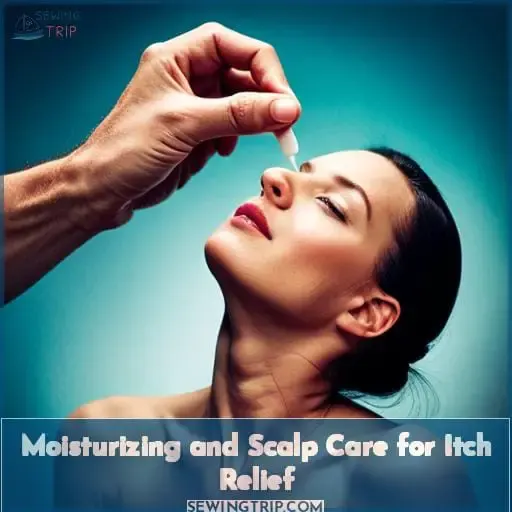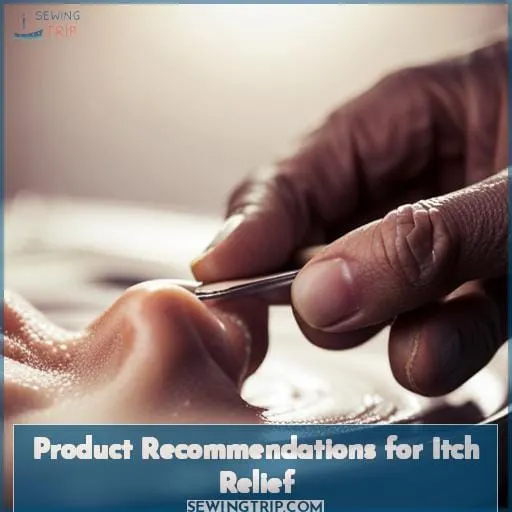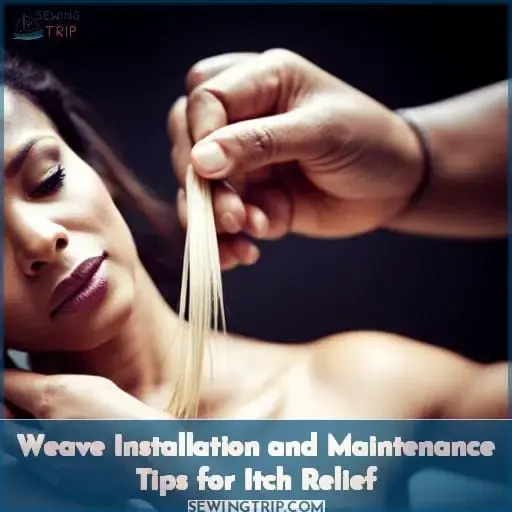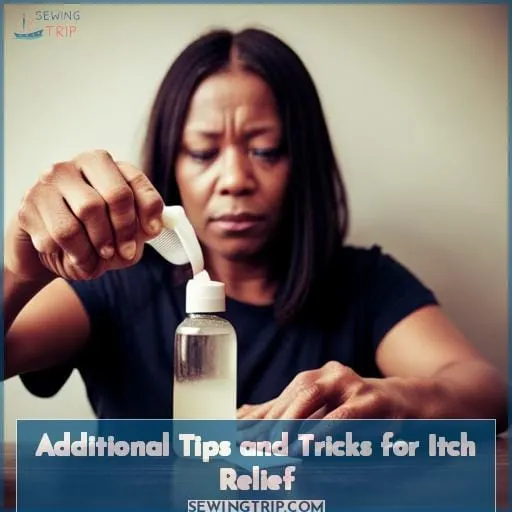This site is supported by our readers. We may earn a commission, at no cost to you, if you purchase through links.
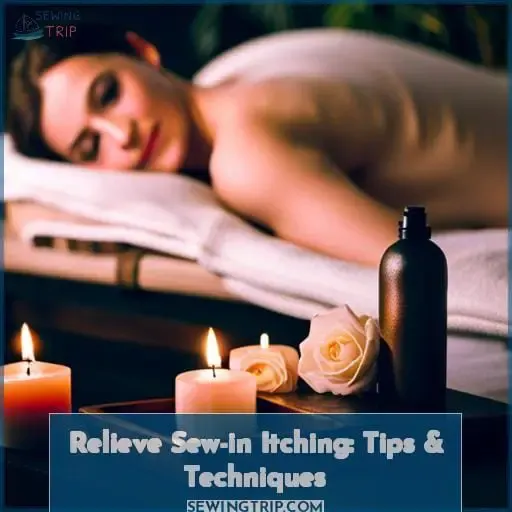 Looking for relief from the itching caused by a sew-in weave? You’re not alone. Many people experience discomfort and irritation after getting a sew-in, but there are solutions to help alleviate that itchiness.
Looking for relief from the itching caused by a sew-in weave? You’re not alone. Many people experience discomfort and irritation after getting a sew-in, but there are solutions to help alleviate that itchiness.
In this article, we’ll share tips and techniques to relieve your scalp from itching while wearing a sew-in weave. From moisturizing your scalp to choosing the right products, we’ve got you covered in finding the freedom from itchy discomfort.
Table Of Contents
Key Takeaways
- Apple Cider Vinegar (ACV) Rinse and tea tree oil can help prepare the scalp and provide relief from itching.
- Using silk pillowcases can prevent bacterial buildup and maintain scalp health.
- Proper moisturization and hydration are crucial for relieving sew-in itching.
- Selecting the right products and taking care of the scalp before and after installation can greatly reduce itching.
Moisturizing and Scalp Care for Itch Relief
To relieve the itching caused by sew-in weaves, it’s important to focus on moisturizing and scalp care.
Pre-installation preparation involves using an apple cider vinegar rinse to prevent itching.
Regular maintenance routines such as moisturizing the scalp every other day with a mixture of tea tree oil and olive oil can provide relief.
Additionally, sleeping on silk pillowcases helps avoid bacterial buildup and dandruff that may contribute to itchiness.
Pre-installation Preparation
Before getting a sew-in weave, make sure you take the necessary steps to moisturize and care for your scalp to prevent itching.
Start by preparing your scalp with a moisturizing routine and using products like tea tree oil or an ACV rinse.
During installation, utilize a color applicator bottle for effective moisture application between tracks.
Additionally, sleep on silk pillowcases to avoid bacterial buildup and dandruff.
Regular Maintenance Routine
To maintain itch relief and promote scalp health, establish a regular maintenance routine for your sew-in weave.
- Moisturize the scalp every other day or at least 3 to 4 times a week using a color applicator bottle.
- Create a mixture of tea tree oil with olive oil for its anti-fungal properties.
- Sleep on silk pillowcases to prevent bacterial buildup and dandruff.
These practices will help address hair texture diversity, styling challenges, and seasonal haircare while relieving scalp itching caused by product buildup or dryness from infrequent shampooing.
Utilizing a Color Applicator Bottle
Start by using a color applicator bottle to effectively moisturize and care for your scalp, providing itch relief during sew-in weave installations.
The color applicator bottle allows for precision moisturizing and track moisturization, ensuring that every part of your scalp is adequately hydrated.
This technique is essential in weave maintenance as it helps alleviate sew-in itching caused by dryness or irritation.
Proper scalp hydration can prevent discomfort and promote a more comfortable experience with your sew-in weave installation.
Tea Tree Oil Mixture for Anti-Fungal Properties
Continue moisturizing and caring for your scalp by incorporating a tea tree oil mixture with anti-fungal properties into your routine.
Tea tree oil is known for its numerous benefits, including its ability to soothe itching and promote scalp health.
To create a DIY mixture, combine 5-10 drops of tea tree oil with olive oil or another carrier oil.
Apply the mixture to your scalp using targeted application techniques, focusing on areas experiencing itchiness.
This will help provide relief and enhance weave comfort while maintaining optimal scalp care.
Tea Tree Benefits, Application Techniques, Scalp Health
Sleeping on Silk Pillowcases
To further enhance the moisturizing and scalp care routine for itch relief, sleep on silk pillowcases.
Silk pillowcase benefits include:
- Hair hydration
- Nighttime comfort
- Preventing frizz
- Promoting skin health
The smooth texture of silk helps to prevent friction and irritation on the scalp while also keeping your hair hydrated throughout the night. This can be especially beneficial for those with dry scalp conditions like psoriasis or those who want to avoid scratching their scalps during sleep.
Additionally, using lightweight styling products before bed can help maintain moisture levels in your hair.
Shampooing and Rinsing Techniques for Itch Relief
To effectively relieve sew-in itching, it’s important to adopt proper shampooing and rinsing techniques.
Frequency and technique play a crucial role in maintaining a healthy scalp while wearing a weave.
Shampoo or co-wash your hair in sections, lifting tracks to ensure thorough cleansing, and consider using braid spray daily for added moisture and itch prevention.
Additionally, make sure to soak up excess water from the braided hair underneath to prevent mildew growth.
Frequency and Technique
You should shampoo more frequently, especially when wearing a sew-in weave, to prevent itching and maintain scalp health.
Proper hygiene is crucial for preventing irritation and itchiness.
When washing your hair, make sure to use a gentle shampoo that cleanses the scalp without stripping away essential oils.
Rinse thoroughly to remove any product residue that can contribute to itching.
Consider incorporating tea tree applications or braid sprays into your routine for added moisture and relief from itchiness caused by dryness.
Sleeping on silk pillowcases can also help reduce friction and promote healthier hair and scalp.
Shampooing or Co-washing in Sections
To effectively alleviate itchiness and promote scalp health, incorporate the practice of shampooing or co-washing in sections.
Sectioned cleansing ensures thorough cleansing of both your natural hair and the weave, preventing product buildup and relieving sew-in pain caused by tightness.
Targeted hydration is essential for maintaining a healthy scalp underneath the weave. Consider using weave-friendly oils to moisturize specific areas prone to itching.
Additionally, a quick dry shampoo can help remove oil and residue without disrupting your hairstyle or causing further irritation on the scalp.
Using Braid Spray for Moisture
When shampooing or co-washing your hair in sections to prevent itchiness under a sew-in weave, it’s important to incorporate the use of braid spray for added moisture and relief.
Using African Royale Braid Spray can provide the necessary hydration to soothe your scalp and alleviate tightness. The braid spray helps moisturize both your natural hair and the braided base, preventing dryness that leads to itching.
Soaking Up Excess Water From Braided Hair
To prevent mildew growth and alleviate itchiness, ensure to soak up excess water from your braided hair after shampooing and rinsing.
Use a soft towel or microfiber cloth to gently pat the hair, focusing on the scalp area. This will help remove any remaining moisture that can lead to discomfort and irritation.
Additionally, consider using a rat tail comb for more precise drying in hard-to-reach areas.
Remember to follow these steps regularly for optimal relief from itching during sew-in weave wear.
Product Recommendations for Itch Relief
When it comes to relieving sew-in itching, there are several product recommendations that can help provide relief.
These include options for:
- Itch relief
- Growth promotion
- Moisturizing solutions
By exploring these different products and finding what works best for you, you can alleviate the discomfort of itching and maintain a healthier scalp while wearing a sew-in weave.
Itch Relief and Growth Promotion
For itch relief and promoting hair growth, there are several product recommendations that can help alleviate discomfort.
Sulfur 8 is a popular option for weave wearers experiencing itching scalp relief. It contains sulfur, which has anti-inflammatory properties that can soothe irritated skin.
Another effective remedy is an apple cider vinegar rinse, known for its antifungal and antibacterial properties. These products provide itch relief while promoting healthy hair growth for those wearing sew-in weaves.
I’m here to help! If you have any questions or need information on a different topic, feel free to ask.
Moisturizing Solutions
To effectively relieve itching caused by sew-in weaves, consider using moisturizing solutions that provide itch relief and promote healthy hair growth.
Some recommended products for itch relief include:
- Sea Breeze
- ACV rinse
- Dudley’s Scalp & Skin Antiseptic
- Sulfur 8
For moisture and hydration, try mixing:
- Infusium 23 braid spray with oil
- Premier rehydrant spray and diluted elasta qp intense conditioner
These moisturizing solutions can help soothe your scalp while keeping your weave looking fresh.
Weave Installation and Maintenance Tips for Itch Relief
To prevent itchiness caused by weave installations, it’s important to take preventive measures before and during the installation process.
This includes:
- Ensuring that the braids aren’t too tight.
- Opting for natural hair extensions instead of synthetic ones to avoid allergic reactions.
- Regularly washing the sew-in based on your hair type.
It’s also crucial to pay attention to the type of weave being used and consider switching or ditching troublesome weaves if problems persist.
Additionally, monitoring the quality of vendors can help in preventing itching caused by poor materials or craftsmanship.
Preventive Measures
To prevent and relieve scalp itching under sew-in weaves, you should take preventive measures during the installation and maintenance of your weave.
These measures include:
- Using sulfate-free cleansing products to prevent product buildup.
- Regularly moisturizing your scalp with oils like Infusium 23 for hydration.
- Ensuring proper hygiene practices to avoid dryness.
By implementing these preventive measures, you can maintain a healthy scalp and alleviate itchiness associated with wearing sew-in weaves.
Paying Attention to Weave Type
Choose the right weave type to minimize itching and ensure a comfortable experience.
Synthetic fibers can cause more irritation compared to natural hair extensions. It’s important to consider underlying skin conditions such as dandruff, dermatitis, or scalp psoriasis when selecting a weave type.
Opt for weaves that offer friction reduction and allow airflow to the scalp.
By paying attention to the weave type, you can alleviate itchiness and promote overall scalp health during your sew-in experience.
I haven’t received any questions related terrorist organizations but if you have any other queries or need assistance with something else feel free ask!
Considering Ditching Troublesome Weaves
If you’re experiencing persistent itching and discomfort, it may be time to consider ditching those troublesome weaves.
Sometimes, despite all efforts to alleviate the itchiness, certain weaves can continue causing irritation and allergic reactions.
It’s essential to prioritize your comfort and scalp health by evaluating whether the weave is worth the ongoing pain.
Remember that maintaining hydration and proper care are crucial for a healthy scalp even without a weave.
Monitoring Vendor’s Quality
When monitoring the quality of your weave vendor, it’s important to pay attention to their track record in providing itch relief and maintaining scalp health.
Look for reviews or testimonials from previous customers who’ve experienced similar issues.
Consider asking others about their experiences with the vendor and whether they were satisfied with the results.
By gathering this information, you can make an informed decision when choosing a reliable vendor who prioritizes itch relief and scalp health.
Additional Tips and Tricks for Itch Relief
To further alleviate itching and discomfort from a sew-in weave, there are additional tips and tricks you can try.
One option is to create a scented apple cider vinegar rinse by adding essential oils like tea tree oil or lavender for a pleasant smell.
If coconut oil makes your hair feel dry, consider exploring alternative moisturizing products that work better for your hair type.
It’s important to experiment with different braids and scalp treatments while staying consistent with your routines to find what works best for relieving itchiness.
Additionally, be aware of the impact of chemical treatments like relaxers on weave-induced itching as they may contribute to scalp irritation.
Scented ACV Rinse
To add a pleasant scent to your ACV rinse and enhance its itch-relieving properties, you can incorporate essential oils like tea tree oil and lavender.
These oils not only provide a delightful fragrance but also have soothing effects on the scalp. Tea tree oil has antimicrobial properties that combat any potential scalp infections, while lavender oil helps calm inflammation and reduce itching sensations.
Simply mix a few drops of these essential oils into your diluted ACV rinse for an enjoyable and effective solution to relieve sew-in itching.
Product Alternatives
To find relief from sew-in itching, try exploring alternative products that can provide moisture and alleviate discomfort.
Heavy products may contribute to itchiness, so consider opting for lightweight alternatives that won’t weigh down your hair.
Avoiding heavy oils and greases can also help prevent buildup and potential mildew growth underneath the weave.
If you’re experiencing persistent itching despite using different products, it’s best to consult a stylist or professional for personalized advice on how to address your specific concerns.
Experimentation and Consistency
To effectively relieve itchiness from a sew-in weave, it’s important to consistently experiment with different braids and scalp treatments.
Some tips and tricks for itch relief include:
- Trying out various types of braids, such as yarn braids or box braids.
- Using different moisturizing products like oils or leave-in conditioners.
- Exploring natural remedies like tea tree oil or apple cider vinegar rinses.
- Maintaining a consistent routine to keep your hair and scalp healthy.
Awareness of Chemicals
- Be aware of the impact that relaxers and natural hair can have on weave-induced itching.
Certain chemicals found in relaxers and the natural texture of your hair can contribute to itchiness when wearing a sew-in weave. It’s important to understand how these factors may affect your scalp and take necessary precautions for relief.
Consider using a color applicator bottle for precise moisturizing, try EVCO (Extra Virgin Coconut Oil) as an alternative, and be mindful of alkaline coating from previous treatments.
| Chemicals | Impact |
|---|---|
| Relaxers | Potential irritants leading to increased itchiness |
| Natural Hair Texture | Prone to dryness which exacerbates itching |
Frequently Asked Questions (FAQs)
Can I use regular shampoo on my scalp while wearing a sew-in weave?
Yes, regular shampoo can be used on your scalp while wearing a sew-in weave. However, opt for sulfate-free shampoos to prevent excessive drying and irritation.
Proper cleansing is crucial for maintaining scalp health and preventing itchiness.
How often should I moisturize my scalp to relieve itching?
To relieve itching while wearing a sew-in weave,
- Moisturize your scalp every other day or 3 to 4 times a week.
Consistency is key in maintaining optimal scalp health and alleviating discomfort.
Are there any specific products or ingredients to avoid for itch relief?
To relieve itching from a sew-in weave,
- Avoid products with harsh chemicals like sulfates and heavy oils that can clog hair follicles.
- Opt for lightweight moisturizers and gentle scalp care products to maintain a healthy, itch-free scalp.
What should I do if my weave is causing severe itching and discomfort?
To alleviate severe itching and discomfort from your weave, try these expert-recommended tips:
- Moisturize regularly with oils
- Shampoo frequently to prevent product buildup
- Use itch relief products like Scalpicin or Sulfur
Are there any natural remedies or DIY treatments for relieving scalp itchiness under sew-in weaves?
To liberate yourself from the discomfort of scalp itchiness under sew-in weaves, try these natural remedies.
Treatments like ACV rinses and tea tree oil mixtures can provide relief and power over irritation.
Conclusion
To find relief from the itching caused by a sew-in weave, it’s important to prioritize moisturizing and scalp care.
[Keypoints]This can be achieved through:
- Pre-installation preparation
- Regular maintenance routines
- The use of moisturizing products
Additionally, proper shampooing and rinsing techniques, along with the use of braid spray and silk pillowcases, can help alleviate itchiness.
Choosing the right products, paying attention to weave installation and maintenance, and being aware of chemicals are also crucial for itch relief.
By following these tips and techniques, you can find freedom from sew-in itching.

